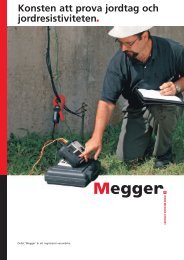A practical guide to earth resistance testing - Weschler Instruments
A practical guide to earth resistance testing - Weschler Instruments
A practical guide to earth resistance testing - Weschler Instruments
You also want an ePaper? Increase the reach of your titles
YUMPU automatically turns print PDFs into web optimized ePapers that Google loves.
Limitations of Stakeless Testing<br />
The clamp-on tester is only effective in situations with multiple grounds in<br />
parallel. It cannot be used on isolated grounds, as there is no return path.<br />
In addition, it cannot be used if there is an alternate lower <strong>resistance</strong> loop<br />
not including ground. Fall-of-potential <strong>testing</strong> is advised for installation<br />
checks or commissioning new sites. General ground <strong>testing</strong> rules apply,<br />
e.g. if another part of the ground system is in the “sphere of influence” of<br />
the electrode under test, the result will be lower than the true <strong>resistance</strong><br />
of the electrode.<br />
A low return path is required for readings that approximate a fall-ofpotential<br />
test result on a particular ground connection. A high <strong>resistance</strong><br />
return path will yield high readings. The point of clamping the tester must<br />
be on the correct part of the loop for the electrode under test, as a wrong<br />
connection may give a faulty reading. The opera<strong>to</strong>r must have a thorough<br />
understanding of the grounding system <strong>to</strong> know exactly what is being<br />
measured.<br />
The method is susceptible <strong>to</strong> noise from nearby electrical apparatus and<br />
older instruments are less effective for very low <strong>resistance</strong> grounds.<br />
A final disadvantage of the clamp-on ground tester is that there is no<br />
built-in proof for the method without disconnection and performing a fallof-potential<br />
test. As noted previously, a clamp-on ground tester should<br />
not be the only ground test instrument used. It is, however, an important<br />
part of the ground <strong>testing</strong> <strong>to</strong>ol kit, along with a fall-of-potential tester.<br />
The clamp-on tester can be used <strong>to</strong> identify problems quickly. A fall-ofpotential<br />
tester can then be used <strong>to</strong> confirm those problem results. This<br />
approach, <strong>to</strong>gether with trending results, allows the opera<strong>to</strong>r <strong>to</strong> be more<br />
productive and improves the early detection of potential faults.<br />
Cell Tower Ground Testing<br />
Communication <strong>to</strong>wers present a problem where clamp-on testers<br />
perform well if used correctly, but measure ‘dead shorts’ if not. The<br />
problem is that the <strong>to</strong>wer is live and provision of services prohibits removal<br />
of power. In America, utilities typically provide a low impedance utility<br />
<strong>earth</strong> connected <strong>to</strong> ground via an <strong>earth</strong>-ground link at the distribution<br />
panel. The stakeless method relies on having a low <strong>resistance</strong> return<br />
path in the loop, so this is an ideal point for clamp-on testers <strong>to</strong> measure<br />
ground <strong>resistance</strong>. Because the utility <strong>earth</strong> is very low, the loop <strong>resistance</strong><br />
measured at the distribution panel ground by the clamp-on tester will be<br />
very close <strong>to</strong> the <strong>resistance</strong> a fall-of-potential measurement would yield.<br />
Note here that a fall-of-potential test would have <strong>to</strong> take in<strong>to</strong> account the<br />
size of the <strong>to</strong>tal site ground system and ensure that long enough leads are<br />
available <strong>to</strong> correctly measure the ground <strong>resistance</strong> outside the sphere of<br />
influence of the ground system.<br />
Figure 24 is an application where the clamp-on method is often misused<br />
at communication <strong>to</strong>wers. This example will help show why knowledge of<br />
the system is critical <strong>to</strong> making the correct test. The illustration shows the<br />
problems with trying <strong>to</strong> use a clamp-on ground tester on a cellular <strong>to</strong>wer.<br />
Cellular <strong>to</strong>wers are grounded at the base, with each guy wire grounded<br />
and all of them connected <strong>to</strong>gether in a ground ring. If the opera<strong>to</strong>r<br />
clamps around the head of one of the guy wire grounds, the test current<br />
will simply complete the<br />
circuit in the ground ring and<br />
not through the soil. Note<br />
that the test current circulates<br />
through the conduc<strong>to</strong>r that<br />
connects the individual<br />
elements (ground rods) that<br />
comprise the ring. As such,<br />
the clamp-on ground tester<br />
will not be measuring the<br />
quality of the ground system.<br />
The reading will actually be a<br />
reading of the <strong>resistance</strong> of<br />
the “loop.”<br />
Fig 24: Cellular <strong>to</strong>wer — example of a<br />
misused application<br />
52 1-866-254-0962 www.megger.com Getting Down <strong>to</strong> Earth 53




